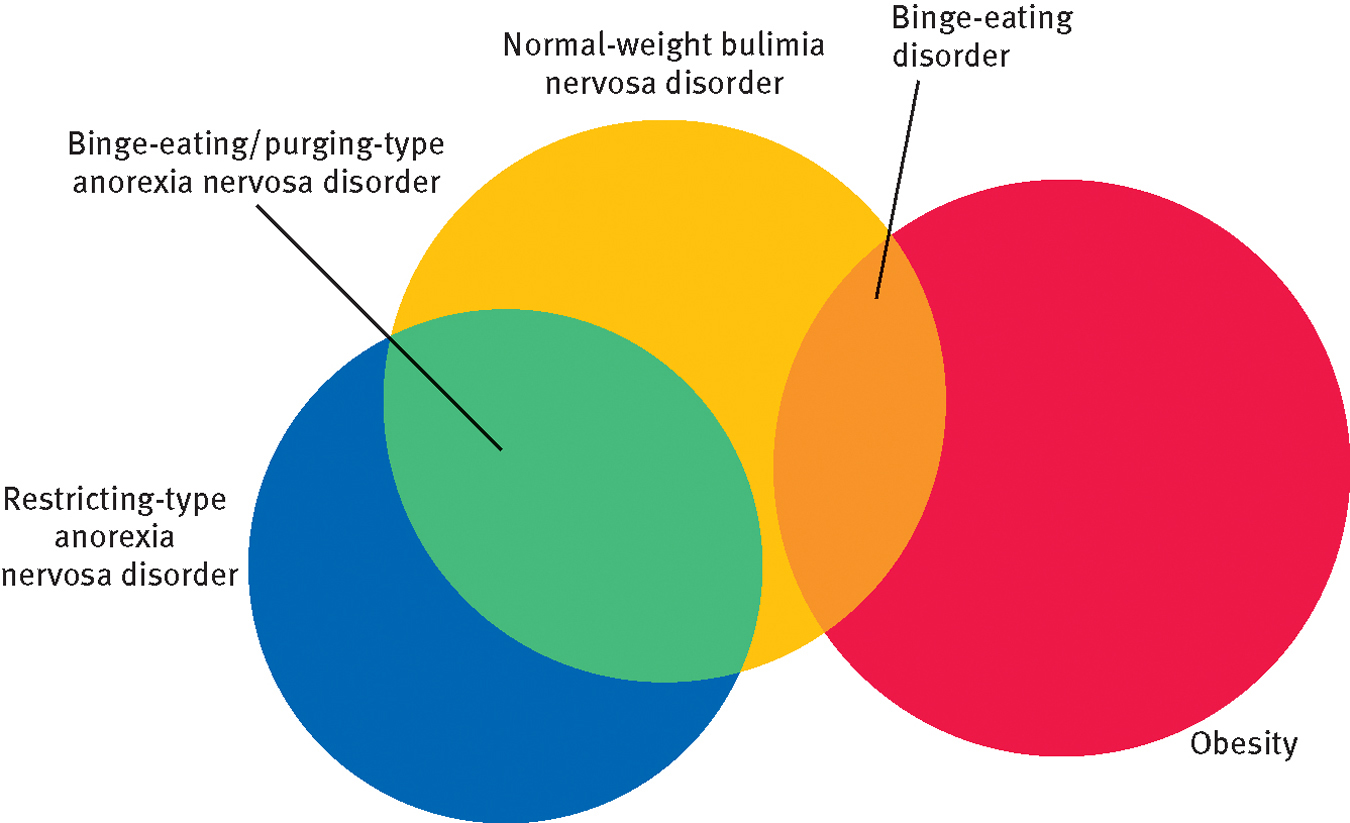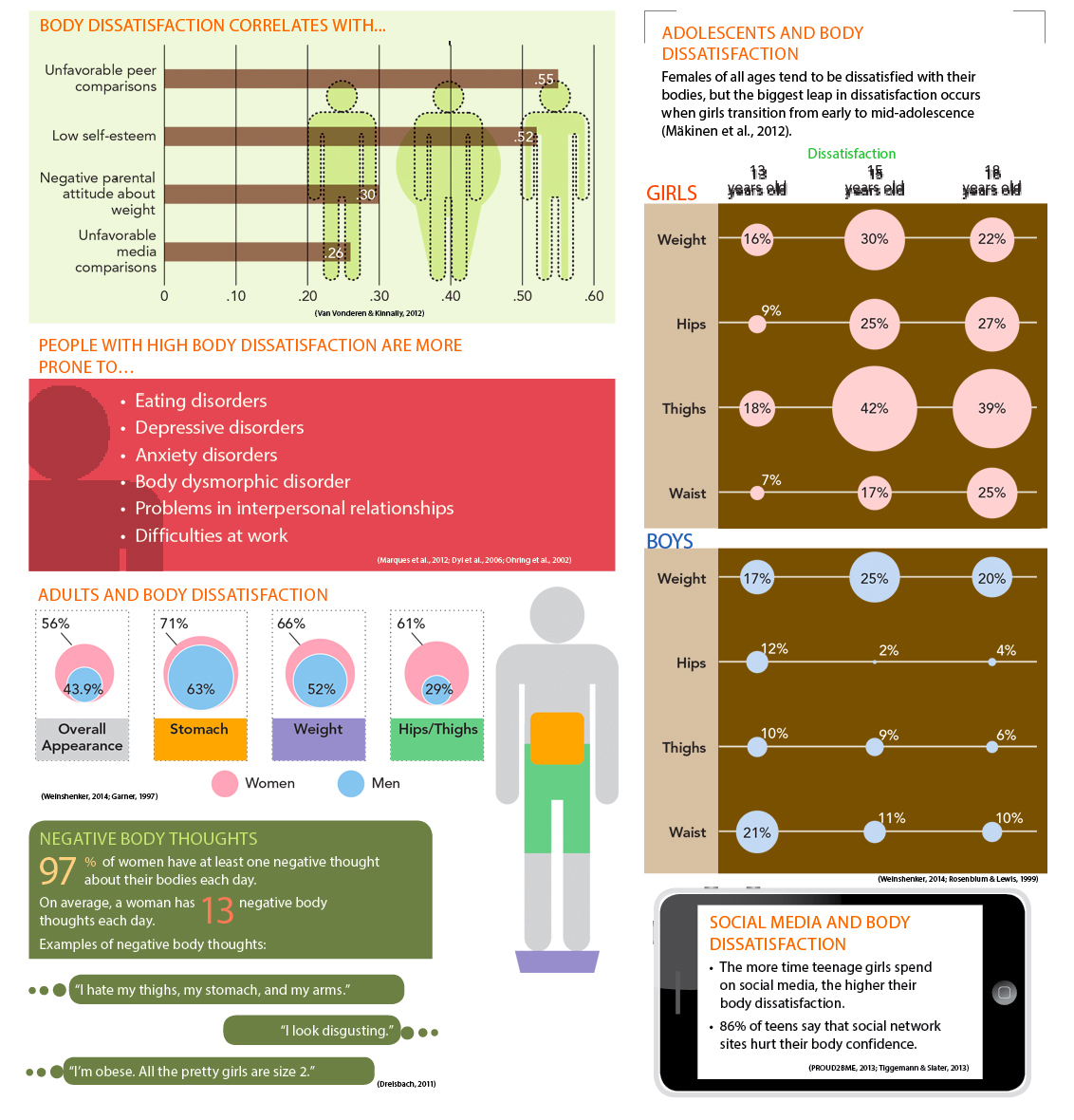11.2 Bulimia Nervosa
|
Bulimia Nervosa |
|
|---|---|
|
1. |
Repeated binge eating episodes. |
|
2. |
Repeated performance of ill- |
|
3. |
Symptoms take place at least weekly for a period of 3 months. |
|
4. |
Inappropriate influence of weight and shape on appraisal of oneself. |
|
(Information from: APA, 2013.) |
|
People with bulimia nervosa—a disorder also known as binge-
 bulimia nervosa A disorder marked by frequent eating binges that are followed by forced vomiting or other extreme compensatory behaviors to avoid gaining weight. Also known as binge-
bulimia nervosa A disorder marked by frequent eating binges that are followed by forced vomiting or other extreme compensatory behaviors to avoid gaining weight. Also known as binge-
 binge An episode of uncontrollable eating during which a person ingests a very large quantity of food.
binge An episode of uncontrollable eating during which a person ingests a very large quantity of food.
Today I am going to be really good and that means eating certain predetermined portions of food and not taking one more bite than I think I am allowed. I am very careful to see that I don’t take more than Doug does. I judge by his body. I can feel the tension building. I wish Doug would hurry up and leave so I can get going!
As soon as he shuts the door, I try to get involved with one of the myriad of responsibilities on the list. I hate them all! I just want to crawl into a hole. I don’t want to do anything. I’d rather eat. I am alone, I am nervous, I am no good, I always do everything wrong anyway, I am not in control, I can’t make it through the day, I just know it. It has been the same for so long.
I remember the starchy cereal I ate for breakfast. I am into the bathroom and onto the scale. It measures the same, but I don’t want to stay the same! I want to be thinner! I look in the mirror, I think my thighs are ugly and deformed looking. I see a lumpy, clumsy, pear-
I float to the refrigerator knowing exactly what is there. I begin with last night’s brownies. I always begin with the sweets. At first I try to make it look like nothing is missing, but my appetite is huge and I resolve to make another batch of brownies. I know there is half of a bag of cookies in the bathroom, thrown out the night before, and I polish them off immediately. I take some milk so my vomiting will be smoother. I like the full feeling I get after downing a big glass. I get out six pieces of bread and toast one side in the broiler, turn them over and load them with patties of butter and put them under the broiler again till they are bubbling. I take all six pieces on a plate to the television and go back for a bowl of cereal and a banana to have along with them. Before the last toast is finished, I am already preparing the next batch of six more pieces. Maybe another brownie or five, and a couple of large bowlfuls of ice cream, yogurt or cottage cheese. My stomach is stretched into a huge ball below my ribcage. I know I’ll have to go into the bathroom soon, but I want to postpone it. I am in never-
I wander aimlessly through each of the rooms again tidying, making the whole house neat and put back together. I finally make the turn into the bathroom. I brace my feet, pull my hair back and stick my finger down my throat, stroking twice, and get up a huge pile of food. Three times, four and another pile of food. I can see everything come back. I am glad to see those brownies because they are SO fattening. The rhythm of the emptying is broken and my head is beginning to hurt. I stand up feeling dizzy, empty and weak. The whole episode has taken about an hour.
(Hall & Cohn, 2010, p. 1; Hall, 1980 pp. 5–
BETWEEN THE LINES
Royal Bulimia?
During her three years as queen of England, Anne Boleyn, King Henry VIII’s second wife, displayed a habit, first observed during her coronation banquet, of vomiting during meals. In fact, she assigned a lady-
Like anorexia nervosa, bulimia nervosa usually occurs in females, again in 90 to 95 percent of the cases (Sanftner & Tantillo, 2011). It begins in adolescence or young adulthood (most often between 15 and 20 years of age) and often lasts for years, with periodic letup (Stice et al., 2013). The weight of people with bulimia nervosa usually stays within a normal range, although it may fluctuate markedly within that range. Some people with this disorder, however, become seriously underweight and may eventually qualify for a diagnosis of anorexia nervosa instead (see Figure 11-1).

Overlapping patterns of anorexia nervosa, bulimia nervosa, and obesity
Some people with anorexia nervosa binge and purge their way to weight loss, and some obese people binge eat. However, most people with bulimia nervosa are not obese, and most overweight people do not binge eat.
Many teenagers and young adults go on occasional eating binges or experiment with vomiting or laxatives after they hear about these behaviors from their friends or the media. Indeed, according to global studies, 25 to 50 percent of all students report periodic binge eating or self-

Binges
People with bulimia nervosa may have between 1 and 30 binge episodes per week (Fairburn et al., 2008). In most cases, they carry out the binges in secret. The person eats massive amounts of food very rapidly, with minimal chewing—
Binges are usually preceded by feelings of great tension. The person feels irritable, “unreal,” and powerless to control an overwhelming need to eat “forbidden” foods. During the binge, the person feels unable to stop eating (APA, 2013). Although the binge itself may be experienced as pleasurable in the sense that it relieves the unbearable tension, it is followed by feelings of extreme self-
Compensatory Behaviors
After a binge, people with bulimia nervosa try to compensate for and undo its effects. Many resort to vomiting, for example. But vomiting actually fails to prevent the absorption of half of the calories consumed during a binge. Furthermore, repeated vomiting affects one’s general ability to feel satiated; thus it leads to greater hunger and more frequent and intense binges. Similarly, the use of laxatives or diuretics largely fails to undo the caloric effects of bingeing (Fairburn et al., 2008).
BETWEEN THE LINES
Climate Control
Women who live in warmer climates (where more revealing clothing is worn) have lower weight, engage in more binge eating and purging, and have more body image concerns than women who live in cooler climates (Sloan, 2002).
Vomiting and other compensatory behaviors may temporarily relieve the uncomfortable physical feelings of fullness or reduce the feelings of anxiety and self-
Every bite that went into my mouth was a naughty and selfish indulgence, and I became more and more disgusted with myself….
The first time I stuck my fingers down my throat was during the last week of school. I saw a girl come out of the bathroom with her face all red and her eyes puffy. She had always talked about her weight and how she should be dieting even though her body was really shapely. I knew instantly what she had just done and I had to try it….
I began with breakfasts which were served buffet-
That year was the first of my nine years of obsessive eating and throwing up…. I didn’t want to tell anyone what I was doing, and I didn’t want to stop…. [Though] being in love or other distractions occasionally lessened the cravings, I always returned to the food.
(Hall & Cohn, 2010, p. 55; Hall, 1980, pp. 9–
As with anorexia nervosa, a bulimic pattern typically begins during or after a period of intense dieting, often one that has been successful and earned praise from family members and friends (Stice & Pressnell, 2010; Couturier & Lock, 2006). Studies of both animals and humans have found that normal research participants placed on very strict diets also develop a tendency to binge (Pankevich et al., 2010; Eifert et al., 2007). Some of the participants in the conscientious objector “starvation study,” for example, later binged when they were allowed to return to regular eating, and a number of them continued to be hungry even after large meals (Keys et al., 1950).
Bulimia Nervosa Versus Anorexia Nervosa

Bulimia nervosa is similar to anorexia nervosa in many ways. Both disorders typically begin after a period of dieting by people who are fearful of becoming obese; driven to become thin; preoccupied with food, weight, and appearance; and struggling with depression, anxiety, obsessiveness, and the need to be perfect (Boone et al., 2014; Holm-
Yet the two disorders also differ in important ways. Although people with either disorder worry about the opinions of others, those with bulimia nervosa tend to be more concerned about pleasing others, being attractive to others, and having intimate relationships (Zerbe, 2010, 2008; Eddy et al., 2004). They also tend to be more sexually experienced and active than people with anorexia nervosa (Gonidakis et al., 2014). Particularly troublesome, they are more likely to have long histories of mood swings, become easily frustrated or bored, and have trouble coping effectively or controlling their impulses and strong emotions (Boone et al., 2014; Lilenfeld, 2011; Halmi, 2010). As many as one-
InfoCentral
BODY DISSATISFACTION
People who evaluate their weight and shape negatively are experiencing body dissatisfaction. Around 73% of all girls and women are dissatisfied with their bodies, compared with 56% of all boys and men (Mintem et al., 2014). The vast majority of dissatisfied females believe they are overweight; in contrast, half of dissatisfied males consider themselves overweight and half consider themselves underweight. The factors most closely tied to body dissatisfaction are perfectionism and unrealistic expectations (Wade & Tiggemann, 2013). Body dissatisfaction is the single most powerful contributor to dieting and to the development of eating disorders.

Another difference is the nature of the medical complications that accompany the two disorders (Corega et al., 2014; Birmingham, 2011; Mitchell & Crow, 2010). Only half of women with bulimia nervosa are amenorrheic or have very irregular menstrual periods, compared with almost all of those with anorexia nervosa. On the other hand, repeated vomiting bathes teeth and gums in hydrochloric acid, leading some women with bulimia nervosa to have serious dental problems, such as breakdown of enamel and even loss of teeth. Moreover, frequent vomiting or chronic diarrhea (from the use of laxatives) can cause dangerous potassium deficiencies, which may lead to weakness, intestinal disorders, kidney disease, or heart damage.
